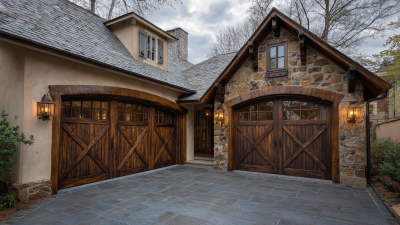When it comes to enhancing your home's energy efficiency, one often overlooked element is the choice of residential garage doors. Your garage door plays a crucial role in maintaining the overall temperature within your home, affecting not only energy consumption but also comfort levels in adjoining living spaces. Selecting the right garage door can lead to significant energy savings and a greener footprint, prompting homeowners to consider various factors such as insulation, material, and design. This guide will walk you through the essential criteria for choosing energy-efficient residential garage doors, ensuring that you make an informed decision that aligns with both your environmental values and practical needs. By following these guidelines, you can transform your garage into a more efficient part of your home while enjoying the benefits of reduced energy bills and increased property value.

When selecting energy-efficient residential garage doors, understanding energy efficiency ratings is crucial. Key metrics to consider include the door's insulation value, often represented by the R-value. A higher R-value indicates better insulation, which helps to maintain consistent temperatures within the garage and the connected living spaces. This not only enhances comfort but also reduces energy consumption, leading to lower utility bills.
Another important metric is the air leakage rating, which measures how well the door prevents air from infiltrating. Look for doors with a low air leakage number, as this reflects their ability to prevent drafts and maintain a stable indoor environment. Additionally, consider the overall design and material of the door. Steel doors, for example, are typically more energy-efficient than wood, especially when combined with proper weather stripping and seals. By focusing on these key metrics, homeowners can make informed decisions that contribute to a more energy-efficient home.
When selecting energy-efficient residential garage doors, understanding insulation materials and their R-values is crucial. R-value measures the thermal resistance of materials, representing how well a door can resist heat flow. A higher R-value indicates better insulation, which can significantly impact energy efficiency and temperature regulation within your garage. For instance, polyurethane foam, often preferred for its high R-value, provides excellent insulation properties, making it an ideal choice for homeowners looking to maintain consistent temperatures while reducing energy costs.
Comparing the insulation materials in garage doors reveals that polystyrene is another common option, typically offering a lower R-value than polyurethane. While it is generally more affordable, it may not deliver the same energy savings in the long run. Homeowners should consider their climate and specific needs when selecting between these materials. Ultimately, investing in a garage door with appropriate insulation can lead to substantial savings on heating and cooling bills while enhancing overall comfort in the home. Careful evaluation of R-values can help ensure that your choice meets both performance expectations and budgetary constraints.

When considering energy-efficient residential garage doors, a comprehensive cost-benefit analysis reveals their significant long-term advantages. The global garage door market is projected to grow from $6.99 billion in 2022 to $9.94 billion by 2029, reflecting a compound annual growth rate (CAGR) of 5.2%. This increase highlights the growing demand for energy-efficient solutions, as homeowners become more aware of the energy savings potential and the environmental impact of their choices.
Investing in energy-efficient garage doors often results in lower energy bills due to improved insulation and durability. According to industry reports, homeowners can save approximately 10% to 30% on energy costs when opting for insulated garage doors. Furthermore, the initial investment is typically recuperated through reduced utility expenses over time, making them a smart financial choice.
Tips: When selecting an energy-efficient garage door, consider those with high R-value ratings, which indicate better insulation properties. Additionally, look for models that utilize sustainable materials, contributing to overall building efficiency. Finally, ensure proper installation, as gaps and leaks can significantly diminish the energy-saving benefits.

When choosing energy-efficient residential garage doors, understanding the leading brands and their innovations is crucial. According to the U.S. Department of Energy, properly insulated garage doors can reduce energy loss by up to 20%. Notably, brands like Clopay and Amarr are recognized for their advanced thermal technologies, offering insulated doors designed with polyurethane cores that provide superior R-values, often exceeding R-18.
In addition to thermal efficiency, these industry leaders are incorporating smart technology into their products. For example, Clopay's Smart Technology allows homeowners to monitor and control their garage doors remotely, enhancing convenience while ensuring energy savings. Similarly, Amarr’s partnership with Energy Star emphasizes their commitment to sustainability, ensuring that their products meet rigorous energy efficiency standards. Data from the International Door Association indicates that energy-efficient garage doors can contribute significantly to a home's overall energy performance, making them an essential consideration for eco-conscious homeowners.
When choosing energy-efficient residential garage doors, installation and maintenance play crucial roles in maximizing their efficiency. Proper installation ensures that the door seals correctly, preventing air leaks and heat loss. According to recent market research, homeowners can significantly reduce energy costs by selecting insulated garage doors, which can lower heating and cooling expenses by up to 20%. Furthermore, ensuring that all components are fitted snugly can enhance the door's performance and longevity.
For optimal energy efficiency, regular maintenance is key. Homeowners should check the weatherstripping around the door frequently and replace it if it shows signs of wear. Lubricating moving parts can not only reduce unwanted noise but also improve the door's operation, thus conserving energy. Additionally, with the increasing trend towards smart technologies, incorporating a modern opener with battery backup can help prevent emergency issues and ensure reliable functionality, which is essential during extreme weather conditions.
When considering upgrades, it's beneficial to explore potential energy tax credits available for such improvements, as recent regulations encourage homeowners to invest in sustainable options. By making informed choices and keeping up with maintenance, homeowners can enhance their garage door's efficiency while also contributing to a more sustainable home environment.
| Feature | Description | Benefits | Maintenance Tips |
|---|---|---|---|
| Insulation | Garage doors with good insulation reduce heat transfer. | Improves energy efficiency, reduces heating/cooling costs. | Check insulation integrity annually. |
| Material | Common materials include steel, wood, and fiberglass. | Different materials offer varying durability and insulation properties. | Inspect for rust or rot, treat accordingly. |
| Seal Quality | Weather seals prevent drafts and water ingress. | Enhances comfort, protects garage contents. | Replace seals as needed, usually every few years. |
| Operability | Types include manual, automatic, or smart doors. | Ease of use and added convenience. | Lubricate moving parts regularly to ensure smooth operation. |
| Style | Classic, modern, carriage house, etc. | Affects curb appeal and home value. | Regularly clean door surface to maintain appearance. |






